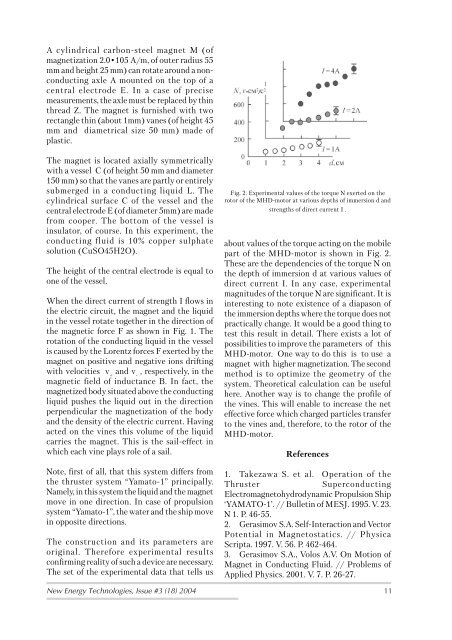Issue 17 - Free-Energy Devices
Issue 17 - Free-Energy Devices
Issue 17 - Free-Energy Devices
You also want an ePaper? Increase the reach of your titles
YUMPU automatically turns print PDFs into web optimized ePapers that Google loves.
A cylindrical carbon-steel magnet M (of<br />
magnetization 2.0•105 A/m, of outer radius 55<br />
mm and height 25 mm) can rotate around a nonconducting<br />
axle A mounted on the top of a<br />
central electrode E. In a case of precise<br />
measurements, the axle must be replaced by thin<br />
thread Z. The magnet is furnished with two<br />
rectangle thin (about 1mm) vanes (of height 45<br />
mm and diametrical size 50 mm) made of<br />
plastic.<br />
The magnet is located axially symmetrically<br />
with a vessel C (of height 50 mm and diameter<br />
150 mm) so that the vanes are partly or entirely<br />
submerged in a conducting liquid L. The<br />
cylindrical surface C of the vessel and the<br />
central electrode E (of diameter 5mm) are made<br />
from cooper. The bottom of the vessel is<br />
insulator, of course. In this experiment, the<br />
conducting fluid is 10% copper sulphate<br />
solution (CuSO45H2O).<br />
The height of the central electrode is equal to<br />
one of the vessel.<br />
When the direct current of strength I flows in<br />
the electric circuit, the magnet and the liquid<br />
in the vessel rotate together in the direction of<br />
the magnetic force F as shown in Fig. 1. The<br />
rotation of the conducting liquid in the vessel<br />
is caused by the Lorentz forces F exerted by the<br />
magnet on positive and negative ions drifting<br />
with velocities v + and v - , respectively, in the<br />
magnetic field of inductance B. In fact, the<br />
magnetized body situated above the conducting<br />
liquid pushes the liquid out in the direction<br />
perpendicular the magnetization of the body<br />
and the density of the electric current. Having<br />
acted on the vines this volume of the liquid<br />
carries the magnet. This is the sail-effect in<br />
which each vine plays role of a sail.<br />
Note, first of all, that this system differs from<br />
the thruster system “Yamato-1” principally.<br />
Namely, in this system the liquid and the magnet<br />
move in one direction. In case of propulsion<br />
system “Yamato-1”, the water and the ship move<br />
in opposite directions.<br />
The construction and its parameters are<br />
original. Therefore experimental results<br />
confirming reality of such a device are necessary.<br />
The set of the experimental data that tells us<br />
New <strong>Energy</strong> Technologies, <strong>Issue</strong> #3 (18) 2004<br />
Fig. 2. Experimental values of the torque N exerted on the<br />
rotor of the MHD-motor at various depths of immersion d and<br />
strengths of direct current I .<br />
about values of the torque acting on the mobile<br />
part of the MHD-motor is shown in Fig. 2.<br />
These are the dependencies of the torque N on<br />
the depth of immersion d at various values of<br />
direct current I. In any case, experimental<br />
magnitudes of the torque N are significant. It is<br />
interesting to note existence of a diapason of<br />
the immersion depths where the torque does not<br />
practically change. It would be a good thing to<br />
test this result in detail. There exists a lot of<br />
possibilities to improve the parameters of this<br />
MHD-motor. One way to do this is to use a<br />
magnet with higher magnetization. The second<br />
method is to optimize the geometry of the<br />
system. Theoretical calculation can be useful<br />
here. Another way is to change the profile of<br />
the vines. This will enable to increase the net<br />
effective force which charged particles transfer<br />
to the vines and, therefore, to the rotor of the<br />
MHD-motor.<br />
References<br />
1. Takezawa S. et al. Operation of the<br />
Thruster Superconducting<br />
Electromagnetohydrodynamic Propulsion Ship<br />
‘YAMATO-1’. // Bulletin of MESJ. 1995. V. 23.<br />
N 1. P. 46-55.<br />
2. Gerasimov S.A. Self-Interaction and Vector<br />
Potential in Magnetostatics. // Physica<br />
Scripta. 1997. V. 56. P. 462-464.<br />
3. Gerasimov S.A., Volos A.V. On Motion of<br />
Magnet in Conducting Fluid. // Problems of<br />
Applied Physics. 2001. V. 7. P. 26-27.<br />
11
















